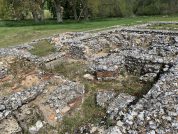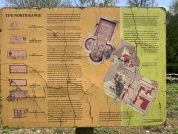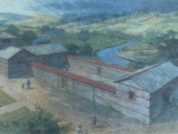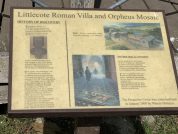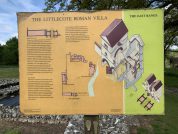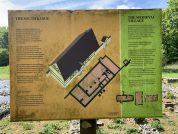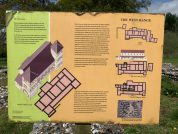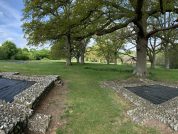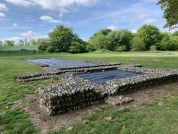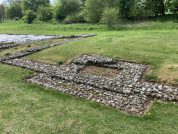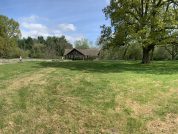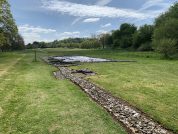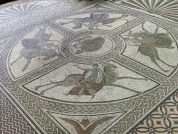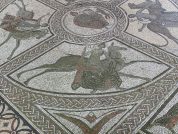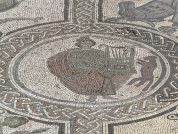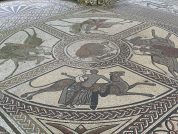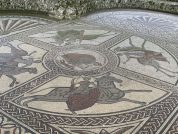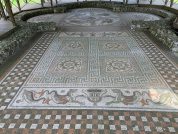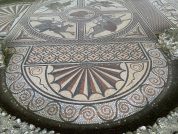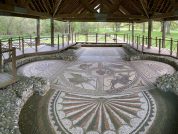Littlecote Roman Villa
Temple Or Shrine and Villa
Littlecote Roman Villa is an extensive and exceptional Roman villa, with associated religious complex, at Littlecote Park in Ramsbury, Wiltshire. It has been excavated and is on display to the public in the grounds of the estate.
In 1727-8 William George discovered the Orpheus mosaic whilst digging post-holes, and it was reported as “the finest pavement that the sun ever shone upon in England”. An engraving and drawing were made and the villa was reburied. Its location eventually disappeared from memory. It was rediscovered in 1976 and the mosaic fully restored by 1980. Excavations of the rest of the site continued under the direction of Bryn Walters till 1991 and the mosaic was protected by a roof in 2000. Since 2018 a new team has taken care of the site and the visible remains have again been restored after a period of neglect.
What did Littlecote Roman Villa look like?
At its height, the villa had around 60 rooms, 2 thermal bath suites, many mosaic floors and several heated hypocausts. The large courtyard villa enclosed an area of about 1 ha, making it one of the largest in Britain. Many of the buildings were two storeys high and included 5 tall towers. The villa had a number of detached workshops and barns.
The separate building with the triconch-form mosaics attached to a large courtyard building is interpreted as a religious cult centre, associated with the pagan revival under Julian the Apostate (361-363). The triconch building is very unusual and similar buildings only exist in North Africa and only much later in the 6th c. Byzantine world.
This mosaic is usually interpreted in very complicated pagan religious terms involving not only Orpheus, but Bacchus and Apollo, the hall being seen as a cult centre for these two gods. Other buildings may have been converted to accommodate visiting pilgrims.
Littlecote Roman Villa & Orpheus mosaic
Orpheus mosaics are found throughout the Roman Empire, normally in large Roman villas. The scene normally shown is Orpheus playing his lyre, and attracting birds and animals of many species to gather around him. Orpheus was a popular subject in classical art, and was also used in Early Christian art as a symbol for Christ.
The Orpheus mosaic at Littlecote was first mentioned in 1727 by William George, the estate steward for Sir Francis Popham, the owner of the Littlecote estate. It was discovered when digging post holes for a new fence around a hunting lodge. The mosaic was recorded by the Society of Antiquaries in April 1728. The antiquarian Roger Gale called it ‘the finest pavement that the sun ever shone upon England’. Sir Francis Popham had the mosaic reburied and deliberately obscured its location, perhaps to avoid having antiquarians invading his grounds to view it. The mosaic was rediscovered in 1977. Half the tiles had survived, and were replaced with modern terracotta tiles modelled on a 1730 engraving by George Vertue which is now held in the Ashmolean Museum, Oxford.
The mosaic is centred on a figure of Orpheus, the musician and priest of Apollo the sun god surrounded by a larger circle divided into quadrants. Within each quadrant is a female deity, each representing one of the four seasons. Here you see Persephone (Kora) with a goat, Venus (Aphrodite) with a hind, Leda (Nemesis) with a panther, and Demeter with a bull. The beasts in each scene have been interpreted as transformations of Bacchus (Zagreus), the son of Zeus, when fleeing from the Titans. The entire sequence relates not only to the seasons but to the cycle of birth, death, and rebirth.
The mosaic could have been made to decorate a summer dining room or the mosaic and the hall in which it stands were part of a ceremonial complex for followers of a sect based on the cult of Bacchus and the legends of Orpheus. Bacchus was considered to be a saviour deity who promised eternal life to his followers.
What is the History of Littlecote Roman Villa?
The settlement begun life as a small short-lived military establishment guarding a road crossing of the River Kennet. It later became a small fortlet to protect the river Kennet route for water-borne transport. From 70 AD the road was still used and the site passed to local ownership with circular huts and in 120 a Roman-style rectangular timber building replaced them (the West Range). In 170 this was replaced by a large two-storeyed winged stone corridor villa with integral bath suite. In the 3rd century the surrounding towns and countryside prospered, reflected in major changes to the villa. In 190 a larger kitchen was added to the rear of the west range, and in 220 the central room was fitted with a hypocaust, and in the baths a hot dry-heat room (laconicum) was added and the cold-plunge was rebuilt with steps. In 250-60 the wings of the villa were extended with more buildings.
In 270-80 all the outer rooms and corridors of the west range were demolished and rebuilt. The baths in the west range were removed and all the hypocaust floors filled in to create a new set of rooms with mosaic floors. Wings connected by a first-floor veranda at the front of the house were completed with corner towers, the south tower having a hypocaust. The south range barn was converted into a residential building with bath suite. In 290 the east wing was built completing the enclosure of 4 wings, and including a large stable block and an impressive gatehouse, the grandest in Britain, with 3 arched vaults supporting long rooms on the floor above, possibly for grain.
The large building in which the Orpheus mosaic was later inserted was built next to the river in 60-80 as a round house and around 100 was converted to an open-sided barn with corn dryers and bread ovens In 300 a small bath suite was inserted. In 310-50 the baths were extended. The corn-dryer was demolished and replaced by a cold bathroom (frigidarium) and a changing room (apodyterium) with fireplace.
The middle of the 4th century saw much upheaval in Roman Britain when many towns and villas were damaged. At Littlecote, in 360 the barn-like part was converted into a courtyard, and the triconch hall was built alongside, with its own elaborate bath suite. Upon its floor was laid the now famous Orpheus mosaic. Also major changes in the functions of the villa took place, from numismatic evidence, as farming ceased but the exotic Orpheus Hall suggests that the site was converted to a religious centre dedicated to the cult of Orpheus and Bacchus which dates to ancient Greece.
Many of the buildings were demolished or fell into decay around 400, shortly after the Theodosian legislation against paganism and before the Roman withdrawal from Britain. Two sub-Roman timber structures have also been identified on the site.
Why Was Littlecote Roman Villa Converted into a Sacred Site?
The transformation occurred during the reign of the pagan emperor Julian the Apostate (reigned 361-363 AD). He had rejected Christianity and tried to return the Roman Empire to the ‘old religions’. During and after Julian’s brief reign many pagan temples and shrines in Britain were restored and new ones built. This may well be what happened here at Littlecote.
Sites near Littlecote Roman Villa
- Cvnetio Settlement (8 km)
Minor Settlement and Possible Roman Fort - Barbury Castle (16 km)
Iron Age Hillfort - Swindon Villa (20 km)
Pottery and Villa - Thatcham (20 km)
Minor Settlement - Andover (Leucomagus) Roman Settlement (24 km)
Minor Settlement - Frilford Temples (29 km)
Amphitheatre and Temple Or Shrine - Cricklade Roman Settlement (30 km)
Minor Settlement - Tidbury Ring (32 km)
Iron Age Hillfort and Villa - Verlucio (33 km)
Minor Settlement - Boscombe (34 km)
Villa
